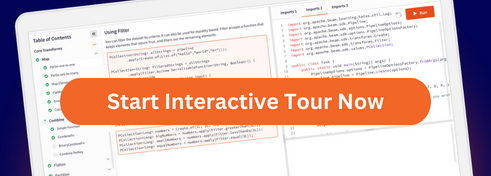Large Language Model Inference in Beam
In Apache Beam 2.40.0, Beam introduced the RunInference API, which lets you deploy a machine learning model in a Beam pipeline. A RunInference transform performs inference on a PCollection of examples using a machine learning (ML) model. The transform outputs a PCollection that contains the input examples and output predictions. For more information, see RunInference here. You can also find inference examples on GitHub.
Using RunInference with very large models
RunInference works well on arbitrarily large models as long as they can fit on your hardware.
Memory Management
RunInference has several mechanisms for reducing memory utilization. For example, by default RunInference load at most a single copy of each model per process (rather than one per thread).
Many Beam runners, however, run multiple Beam processes per machine at once. This can cause problems since the memory footprint of loading large models like LLMs multiple times can be too large to fit into a single machine.
For memory-intensive models, RunInference provides a mechanism for more intelligently sharing memory across multiple processes to reduce the overall memory footprint. To enable this mode, users just have
to set the parameter large_model to True in their model configuration (see below for an example), and Beam will take care of the memory management.
Running an Example Pipeline with T5
This example demonstrates running inference with a T5 language model using RunInference in a pipeline. T5 is an encoder-decoder model pre-trained on a multi-task mixture of unsupervised and supervised tasks. Each task is converted into a text-to-text format. The example uses T5-11B, which contains 11 billion parameters and is 45 GB in size. In order to work well on a variety of tasks, T5 prepends a different prefix to the input corresponding to each task. For example, for translation, the input would be: translate English to German: … and for summarization, it would be: summarize: …. For more information about T5 see the T5 overiew in the HuggingFace documentation.
To run inference with this model, first, install apache-beam 2.40 or greater:
pip install apache-beam -U
Next, install the required packages listed in requirements.txt and pass the required arguments. You can download the T5-11b model from Hugging Face Hub with the following steps:
- Install Git LFS following the instructions here
- Run
git lfs install - Run
git clone https://huggingface.co/t5-11b(this may take a long time). This will download the checkpoint, then you need to convert it to the model state dict as described here:
import torch
from transformers import T5ForConditionalGeneration
model = T5ForConditionalGeneration.from_pretrained("path/to/cloned/t5-11b")
torch.save(model.state_dict(), "path/to/save/state_dict.pth")
You can view the code on GitHub
- Locally on your machine:
python main.py --runner DirectRunner \
--model_state_dict_path <local or remote path to state_dict> \
--model_name t5-11b
You need to have 45 GB of disk space available to run this example.
- On Google Cloud using Dataflow:
python main.py --runner DataflowRunner \
--model_state_dict_path <gs://path/to/saved/state_dict.pth> \
--model_name t5-11b \
--project <PROJECT_ID> \
--region <REGION> \
--requirements_file requirements.txt \
--staging_location <gs://path/to/staging/location>
--temp_location <gs://path/to/temp/location> \
--experiments "use_runner_v2,no_use_multiple_sdk_containers" \
--machine_type=n1-highmem-16 \
--disk_size_gb=200
You can also pass other configuration parameters as described here.
Pipeline Steps
The pipeline contains the following steps:
- Read the inputs.
- Encode the text into transformer-readable token ID integers using a tokenizer.
- Use RunInference to get the output.
- Decode the RunInference output and print it.
The following code snippet contains the four steps:
with beam.Pipeline(options=pipeline_options) as pipeline:
_ = (
pipeline
| "CreateInputs" >> beam.Create(task_sentences)
| "Preprocess" >> beam.ParDo(Preprocess(tokenizer=tokenizer))
| "RunInference" >> RunInference(model_handler=model_handler)
| "PostProcess" >> beam.ParDo(Postprocess(tokenizer=tokenizer))
)In the third step of pipeline we use RunInference.
In order to use it, you must first define a ModelHandler. RunInference provides model handlers for PyTorch, TensorFlow and Scikit-Learn. Because the example uses a PyTorch model, it uses the PyTorchModelHandlerTensor model handler.
A ModelHandler requires parameters like:
state_dict_path– The path to the saved dictionary of the model state.model_class– The class of the Pytorch model that defines the model structure.model_params– A dictionary of arguments required to instantiate the model class.device– The device on which you wish to run the model. If device = GPU then a GPU device will be used if it is available. Otherwise, it will be CPU.inference_fn- The inference function to use during RunInference.large_model- (seeMemory Managementabove). Whether to use memory minimization techniques to lower the memory footprint of your model.
Last updated on 2024/07/26
Have you found everything you were looking for?
Was it all useful and clear? Is there anything that you would like to change? Let us know!



